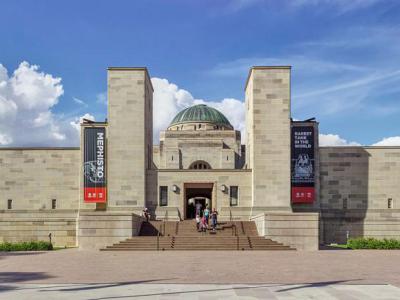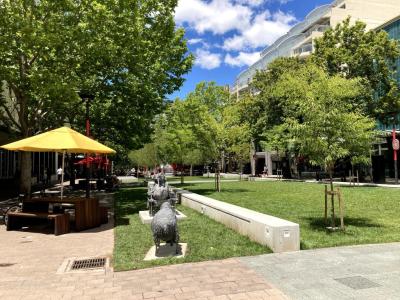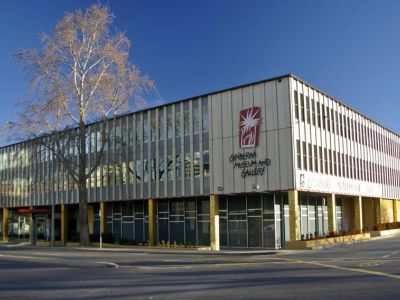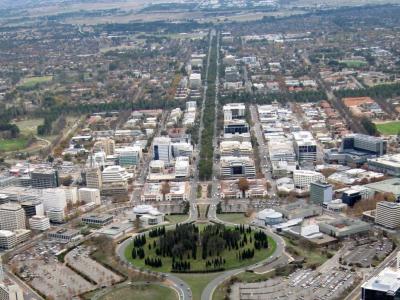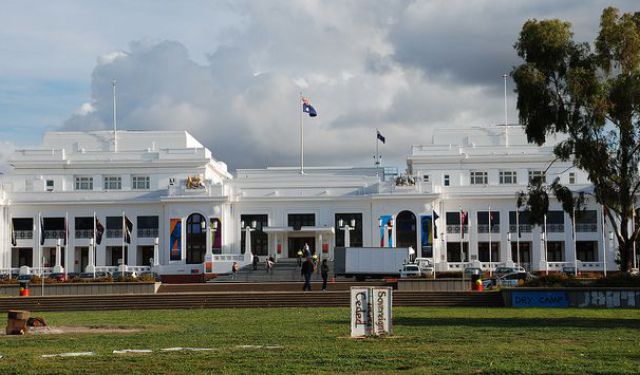
Canberra Civic Center Walking Tour (Self Guided), Canberra
Civic Centre, often simply called Civic, lies at the heart of Canberra, Australia's purpose-built capital. This central district is not only a hub for shopping and dining but also a significant cultural and historical site. At its core, lie an array of landmarks that tell the story of the city's past and vibrant present.
Starting with the Australian War Memorial, located at the northeastern end of Anzac Parade, this site commands a solemn presence. It serves as a tribute to Australians who have died in wars, providing a profound historical context that resonates throughout the capital. Anzac Parade itself, a grand boulevard lined with commemorative sites and sculptures, extends south from the War Memorial, forming a ceremonial axis with Parliament House.
In the commercial heart of Civic, Bunda Street intersects with Garema Place, both of which are bustling pedestrian areas teeming with shops, cafes, and the spontaneous energy of street performers. Nearby, the Canberra Centre, a large shopping mall, offers a range of retail options, from high-end boutiques to mainstream brands.
City Walk and Civic Square further complement the area's lively atmosphere. City Walk is a popular pedestrian thoroughfare dotted with art and casual seating areas, while Civic Square is a space hosting various public events and exhibitions.
The Canberra Museum and Gallery on London Circuit provides insights into Canberra’s social history and visual arts, offering exhibitions that reflect both the local and national spirit.
Finally, Northbourne Avenue marks the entrance to Civic from the north and is a major thoroughfare lined with significant buildings and bustling with activity, encapsulating the energetic pulse of the city.
Canberra's city center is constantly transforming. Each time you visit, you may find a new shop or fresh eatery opening its doors. But rest assured, Civic always offers a slice of Canberra’s best. So, join us in the heart of the Australian capital and discover the vibrant community spirit and rich heritage that make Civic a key destination in Canberra.
Starting with the Australian War Memorial, located at the northeastern end of Anzac Parade, this site commands a solemn presence. It serves as a tribute to Australians who have died in wars, providing a profound historical context that resonates throughout the capital. Anzac Parade itself, a grand boulevard lined with commemorative sites and sculptures, extends south from the War Memorial, forming a ceremonial axis with Parliament House.
In the commercial heart of Civic, Bunda Street intersects with Garema Place, both of which are bustling pedestrian areas teeming with shops, cafes, and the spontaneous energy of street performers. Nearby, the Canberra Centre, a large shopping mall, offers a range of retail options, from high-end boutiques to mainstream brands.
City Walk and Civic Square further complement the area's lively atmosphere. City Walk is a popular pedestrian thoroughfare dotted with art and casual seating areas, while Civic Square is a space hosting various public events and exhibitions.
The Canberra Museum and Gallery on London Circuit provides insights into Canberra’s social history and visual arts, offering exhibitions that reflect both the local and national spirit.
Finally, Northbourne Avenue marks the entrance to Civic from the north and is a major thoroughfare lined with significant buildings and bustling with activity, encapsulating the energetic pulse of the city.
Canberra's city center is constantly transforming. Each time you visit, you may find a new shop or fresh eatery opening its doors. But rest assured, Civic always offers a slice of Canberra’s best. So, join us in the heart of the Australian capital and discover the vibrant community spirit and rich heritage that make Civic a key destination in Canberra.
How it works: Download the app "GPSmyCity: Walks in 1K+ Cities" from Apple App Store or Google Play Store to your mobile phone or tablet. The app turns your mobile device into a personal tour guide and its built-in GPS navigation functions guide you from one tour stop to next. The app works offline, so no data plan is needed when traveling abroad.
Canberra Civic Center Walking Tour Map






Guide Name: Canberra Civic Center Walking Tour
Guide Location: Australia » Canberra (See other walking tours in Canberra)
Guide Type: Self-guided Walking Tour (Sightseeing)
# of Attractions: 9
Tour Duration: 2 Hour(s)
Travel Distance: 2.6 Km or 1.6 Miles
Author: nataly
Sight(s) Featured in This Guide:
Guide Location: Australia » Canberra (See other walking tours in Canberra)
Guide Type: Self-guided Walking Tour (Sightseeing)
# of Attractions: 9
Tour Duration: 2 Hour(s)
Travel Distance: 2.6 Km or 1.6 Miles
Author: nataly
Sight(s) Featured in This Guide:
- Australian War Memorial
- Anzac Parade
- Bunda Street
- Garema Place
- Canberra Centre
- City Walk
- Civic Square
- Canberra Museum and Gallery
- Northbourne Avenue
1) Australian War Memorial (must see)
The Australian War Memorial stands as a poignant tribute to the nation's armed forces and supporting organizations who have served and sacrificed in wars. Officially opened in 1941, it has grown into one of the most respected and comprehensive memorials of its kind globally. The Memorial is dedicated to honoring the memory of those who have died in the service of Australia and providing a space for reflection and remembrance.
The Australian War Memorial is divided into three distinct sections: the Commemorative Area, the galleries (museum), and the Research Centre. The Commemorative Area houses the Hall of Memory, which contains the Tomb of the Unknown Australian Soldier, a symbol of all Australians who have died in conflict. This area serves as a central shrine for commemoration and includes a solemn space for visitors to pay their respects. The Memorial's galleries feature a rich collection of military artifacts, personal stories, and exhibitions that chronicle Australia's wartime history.
In addition to the indoor exhibits, the Memorial also features an outdoor Sculpture Garden, where visitors can view various commemorative sculptures and installations. This garden provides a reflective space amidst the natural surroundings of the site.
As a national institution, the Australian War Memorial not only serves as a place of remembrance but also as a resource for research, housing an extensive archive of military records and documents.
The Australian War Memorial is divided into three distinct sections: the Commemorative Area, the galleries (museum), and the Research Centre. The Commemorative Area houses the Hall of Memory, which contains the Tomb of the Unknown Australian Soldier, a symbol of all Australians who have died in conflict. This area serves as a central shrine for commemoration and includes a solemn space for visitors to pay their respects. The Memorial's galleries feature a rich collection of military artifacts, personal stories, and exhibitions that chronicle Australia's wartime history.
In addition to the indoor exhibits, the Memorial also features an outdoor Sculpture Garden, where visitors can view various commemorative sculptures and installations. This garden provides a reflective space amidst the natural surroundings of the site.
As a national institution, the Australian War Memorial not only serves as a place of remembrance but also as a resource for research, housing an extensive archive of military records and documents.
2) Anzac Parade
ANZAC Parade in Canberra is a prominent ceremonial road, deeply ingrained in Australia's military history. Named in honor of the Australian and New Zealand Army Corps (ANZAC) of World War I, the parade connects the Gallipoli Reach of Lake Burley Griffin to the south and the Australian War Memorial to the north. This strategic location places ANZAC Parade on the main axis between Parliament House and Mount Ainslie, further emphasizing its importance in the layout of the Australian capital. The parade also bisects Constitution Avenue, a key road in Canberra’s Parliamentary Triangle, linking the Civic area with Russell Hill.
Flanked by Eucalyptus trees, ANZAC Parade offers a dignified and serene setting, with its three-lane road gently sloping upwards toward the Australian War Memorial. This setting is fitting for the many significant military memorials that line the parade, each commemorating different aspects of Australia’s military history. These memorials serve as a poignant reminder of the sacrifices made by Australian and New Zealand forces in conflicts across the globe.
The parade's historical and cultural significance was formally recognized on ANZAC Day, April 25, 2006, when it, along with the Australian War Memorial, was added to the National Heritage List. This designation underscores the parade's role not only as a key thoroughfare in Canberra but also as a national symbol of remembrance and reflection. ANZAC Parade remains a central venue for commemorative events, particularly on ANZAC Day, where it serves as the focal point for ceremonies honoring the bravery and service of Australian and New Zealand soldiers.
Flanked by Eucalyptus trees, ANZAC Parade offers a dignified and serene setting, with its three-lane road gently sloping upwards toward the Australian War Memorial. This setting is fitting for the many significant military memorials that line the parade, each commemorating different aspects of Australia’s military history. These memorials serve as a poignant reminder of the sacrifices made by Australian and New Zealand forces in conflicts across the globe.
The parade's historical and cultural significance was formally recognized on ANZAC Day, April 25, 2006, when it, along with the Australian War Memorial, was added to the National Heritage List. This designation underscores the parade's role not only as a key thoroughfare in Canberra but also as a national symbol of remembrance and reflection. ANZAC Parade remains a central venue for commemorative events, particularly on ANZAC Day, where it serves as the focal point for ceremonies honoring the bravery and service of Australian and New Zealand soldiers.
3) Bunda Street
Bunda Street in Canberra is a key part of the Civic shopping area. This shared traffic zone, which stretches between Northbourne Avenue and Glebe Park, is lined with an array of boutique and modern fashion stores, making it a popular spot for shopping enthusiasts.
The street is not just about shopping; it also boasts a lively café culture and nightlife. Cafés like Gus's in the Garema Centre offer a cozy place to relax, while the numerous nightclubs provide an energetic atmosphere for evening entertainment. This mix of retail and leisure options makes Bunda Street a central hub of activity in Canberra.
Adding to its unique character, Bunda Street passes underneath the Canberra Centre, one of the city's major shopping complexes. This architectural feature marks the end of the shared zone, blending seamlessly into the broader Civic area, and highlights the street's integration into the city's urban landscape.
The street is not just about shopping; it also boasts a lively café culture and nightlife. Cafés like Gus's in the Garema Centre offer a cozy place to relax, while the numerous nightclubs provide an energetic atmosphere for evening entertainment. This mix of retail and leisure options makes Bunda Street a central hub of activity in Canberra.
Adding to its unique character, Bunda Street passes underneath the Canberra Centre, one of the city's major shopping complexes. This architectural feature marks the end of the shared zone, blending seamlessly into the broader Civic area, and highlights the street's integration into the city's urban landscape.
4) Garema Place
Garema Place is a vibrant, pedestrian-friendly outdoor area in Civic, known for its bustling atmosphere, numerous shops, restaurants, and cafes offering outdoor dining. As a central hub within the city's CBD, it serves as a popular location for community events, including protests, festivals, and public gatherings. The area's significance as a social and cultural gathering place is reflected in its role as the venue for major events such as Canberra's Multicultural Festival in February and the Celebrate Canberra Festival in March.
The history of Garema Place is deeply rooted in Canberra's early development. Originally gazetted as a city street in October 1952, the site was once home to the Civic Centre railway station, which opened in 1921 as Canberra's second goods rail terminal. However, the station was short-lived, closing in 1922 after a flood washed away the rail bridge over the Molonglo River. The rail corridor that once ran through what is now City Walk was preserved until the 1950s when plans for a central city railway were abandoned, and the area began its transformation into a pedestrian plaza by the mid-1960s.
Today, Garema Place is not only a commercial and social hub but also a site of artistic expression, featuring various sculptures and artworks by local artists. Among these, "The Cushion and the Wedge," a silver statue resembling a pillow, is a notable piece often referred to as the 'Goon Bag' due to its likeness to a popular Australian icon. Another significant addition is the "Big Swoop," a sculpture commemorating the Australian magpie, a bird known for its melodious calls and notorious swooping behavior during the breeding season. Installed in March 2022, the statue faced vandalism but was rebuilt and returned to its original spot by December 2022, now more resilient and ready to withstand the elements and the test of time.
The history of Garema Place is deeply rooted in Canberra's early development. Originally gazetted as a city street in October 1952, the site was once home to the Civic Centre railway station, which opened in 1921 as Canberra's second goods rail terminal. However, the station was short-lived, closing in 1922 after a flood washed away the rail bridge over the Molonglo River. The rail corridor that once ran through what is now City Walk was preserved until the 1950s when plans for a central city railway were abandoned, and the area began its transformation into a pedestrian plaza by the mid-1960s.
Today, Garema Place is not only a commercial and social hub but also a site of artistic expression, featuring various sculptures and artworks by local artists. Among these, "The Cushion and the Wedge," a silver statue resembling a pillow, is a notable piece often referred to as the 'Goon Bag' due to its likeness to a popular Australian icon. Another significant addition is the "Big Swoop," a sculpture commemorating the Australian magpie, a bird known for its melodious calls and notorious swooping behavior during the breeding season. Installed in March 2022, the statue faced vandalism but was rebuilt and returned to its original spot by December 2022, now more resilient and ready to withstand the elements and the test of time.
5) Canberra Centre
The Canberra Centre, originally known as the Monaro Mall, holds a special place in Australia's retail history as the first three-storey, fully enclosed, and air-conditioned shopping center in the country. Officially opened by Prime Minister Robert Menzies on March 6, 1963, the mall quickly became a central hub for shopping in Canberra. At its inception, it housed major retailers such as David Jones, Marcus Clark & Co., Coles New World Supermarket, and McEwans Hardware, along with 58 specialty shops. This pioneering development set the stage for the Canberra Centre's long-standing significance in the city's commercial landscape.
In 1989, the mall underwent a major redevelopment and was rebranded as the Canberra Centre, marking a new era for the shopping precinct. The redevelopment, officially inaugurated by Rosemary Follett on November 2, 1989, expanded the center to include four city blocks, with David Jones, Myer, City Market, and Target as anchor stores. The redesign included modernized facilities, improved accessibility, and the addition of travelators to connect different parts of the mall, although these were later demolished. This expansion solidified the Canberra Centre's position as a premier shopping destination in the region.
Further enhancements were made to the Canberra Centre in the late 2000s, including the addition of a Dendy Cinema complex and a greater variety of retailers and services. The center faced challenges, such as the severe storm on February 28, 2007, which caused significant damage due to flooding. However, the Canberra Centre continued to evolve, with a renovated section of the mall, known as the Monaro Mall, reopening in July 2017 as a beauty precinct. This renovation introduced high-end brands like Jurlique, Lush, and Mecca Maxima, and was followed by the arrival of new fashion brands like H&M, Gorman, and Calvin Klein.
The end of 2018 and 2019 saw further expansion, with the addition of globally recognized brands such as Superdry, Nike, and Levi's, ensuring the Canberra Centre remains a vibrant and dynamic shopping destination.
In 1989, the mall underwent a major redevelopment and was rebranded as the Canberra Centre, marking a new era for the shopping precinct. The redevelopment, officially inaugurated by Rosemary Follett on November 2, 1989, expanded the center to include four city blocks, with David Jones, Myer, City Market, and Target as anchor stores. The redesign included modernized facilities, improved accessibility, and the addition of travelators to connect different parts of the mall, although these were later demolished. This expansion solidified the Canberra Centre's position as a premier shopping destination in the region.
Further enhancements were made to the Canberra Centre in the late 2000s, including the addition of a Dendy Cinema complex and a greater variety of retailers and services. The center faced challenges, such as the severe storm on February 28, 2007, which caused significant damage due to flooding. However, the Canberra Centre continued to evolve, with a renovated section of the mall, known as the Monaro Mall, reopening in July 2017 as a beauty precinct. This renovation introduced high-end brands like Jurlique, Lush, and Mecca Maxima, and was followed by the arrival of new fashion brands like H&M, Gorman, and Calvin Klein.
The end of 2018 and 2019 saw further expansion, with the addition of globally recognized brands such as Superdry, Nike, and Levi's, ensuring the Canberra Centre remains a vibrant and dynamic shopping destination.
6) City Walk
City Walk is a vibrant pedestrian thoroughfare in the heart of Civic, offering a dynamic blend of retail, entertainment, and cultural experiences. Established in January 1975 by closing off traffic on Alinga Street between East Row and Binara Street, City Walk has become a bustling outdoor space where pedestrians can explore the area with ease, only needing to cross Akuna Street.
The walk intersects with other popular spots such as Garema Place and Petrie Plaza, further enhancing its appeal. Along City Walk, visitors can find several iconic landmarks, including the Canberra Merry-Go-Round, the Centrepoint arcade, the Canberra Centre shopping mall, and the Canberra Times fountain. These features make City Walk a central hub for shopping, relaxation, and enjoying Canberra’s urban landscape.
City Walk is also a hotspot for cultural activities, frequently hosting street performers and events, most notably the National Multicultural Festival. This vibrant atmosphere, combined with its convenient and pedestrian-friendly layout, makes City Walk a key destination for both locals and tourists in Canberra.
The walk intersects with other popular spots such as Garema Place and Petrie Plaza, further enhancing its appeal. Along City Walk, visitors can find several iconic landmarks, including the Canberra Merry-Go-Round, the Centrepoint arcade, the Canberra Centre shopping mall, and the Canberra Times fountain. These features make City Walk a central hub for shopping, relaxation, and enjoying Canberra’s urban landscape.
City Walk is also a hotspot for cultural activities, frequently hosting street performers and events, most notably the National Multicultural Festival. This vibrant atmosphere, combined with its convenient and pedestrian-friendly layout, makes City Walk a key destination for both locals and tourists in Canberra.
7) Civic Square
Civic Square is a significant cultural and governmental hub, housing key institutions such as the Australian Capital Territory Legislative Assembly, Canberra Museum and Gallery, Civic Library, and Canberra Theatre. It also hosts various cultural organizations, including the Canberra division of the National Trust of Australia. Designed by Yuncken Freeman architects and completed in 1961, Civic Square is positioned along a primary axis in Walter Burley Griffin's design for Canberra, linking City Hill and Mount Ainslie. Griffin envisioned the square as the "heart of the city," a vision that has been realized over the decades.
The Canberra Theatre, a cornerstone of Civic Square, opened its doors in June 1965 with a performance of Swan Lake by the Australian Ballet. The Playhouse, originally built alongside the theatre in 1965, was demolished and rebuilt in 1998, further modernizing the precinct. The connection between the Theatre and Playhouse buildings now includes the Civic Library, as well as the theatre's bar and administrative areas, making it a central point for cultural and social activities in Canberra.
A prominent feature of Civic Square is the "Ethos" sculpture by Tom Bass, commissioned by the National Capital Development Commission in 1959 and unveiled in 1961. This sculpture, which Bass considered his most important civic work, symbolizes the spirit of the Canberra community. The figure is robed in a fabric embossed with emblems representing the community, and it stands on a six-sided saucer that reflects the hexagonal plan of Civic Square. The sculpture's bursting sun represents culture and enlightenment, aligning with Canberra's role as a center of education, research, and diplomacy.
Throughout the 1960s and 70s, the "Ethos" sculpture was frequently featured in tourism images, underscoring its importance as an emblem of Canberra's identity.
The Canberra Theatre, a cornerstone of Civic Square, opened its doors in June 1965 with a performance of Swan Lake by the Australian Ballet. The Playhouse, originally built alongside the theatre in 1965, was demolished and rebuilt in 1998, further modernizing the precinct. The connection between the Theatre and Playhouse buildings now includes the Civic Library, as well as the theatre's bar and administrative areas, making it a central point for cultural and social activities in Canberra.
A prominent feature of Civic Square is the "Ethos" sculpture by Tom Bass, commissioned by the National Capital Development Commission in 1959 and unveiled in 1961. This sculpture, which Bass considered his most important civic work, symbolizes the spirit of the Canberra community. The figure is robed in a fabric embossed with emblems representing the community, and it stands on a six-sided saucer that reflects the hexagonal plan of Civic Square. The sculpture's bursting sun represents culture and enlightenment, aligning with Canberra's role as a center of education, research, and diplomacy.
Throughout the 1960s and 70s, the "Ethos" sculpture was frequently featured in tourism images, underscoring its importance as an emblem of Canberra's identity.
8) Canberra Museum and Gallery
The Canberra Museum and Gallery (CMAG) serves as a vital cultural institution within the city. Opened on February 13, 1998, CMAG has become a hub for art, history, and cultural exhibitions that reflect the social and artistic heritage of Canberra and the Australian Capital Territory (ACT). The museum and gallery offer a diverse range of exhibits, including powerful displays on significant local events, such as the devastating Canberra bushfires of 2003, which left an indelible mark on the community.
CMAG features several galleries spread across two floors, each hosting different exhibitions that range from paintings and photography to works of art and artifacts that tell the social history of the region. Over its first five years, CMAG curated an impressive 158 exhibitions, demonstrating its commitment to showcasing a broad spectrum of artistic and historical narratives. Entry to the gallery is free, making it an accessible space for both locals and visitors to engage with Canberra’s rich cultural tapestry.
In addition to its primary functions, CMAG also houses the Nolan Collection, a significant body of work by renowned Australian artist Sidney Nolan. Furthermore, ACT Historic Places, which includes historic sites like Lanyon, Calthorpes’ House, and Mugga Mugga, falls under the umbrella of ACT Museums and Galleries, the larger entity of which CMAG is a part.
CMAG features several galleries spread across two floors, each hosting different exhibitions that range from paintings and photography to works of art and artifacts that tell the social history of the region. Over its first five years, CMAG curated an impressive 158 exhibitions, demonstrating its commitment to showcasing a broad spectrum of artistic and historical narratives. Entry to the gallery is free, making it an accessible space for both locals and visitors to engage with Canberra’s rich cultural tapestry.
In addition to its primary functions, CMAG also houses the Nolan Collection, a significant body of work by renowned Australian artist Sidney Nolan. Furthermore, ACT Historic Places, which includes historic sites like Lanyon, Calthorpes’ House, and Mugga Mugga, falls under the umbrella of ACT Museums and Galleries, the larger entity of which CMAG is a part.
9) Northbourne Avenue
Northbourne Avenue is one of Canberra's most significant thoroughfares, running north–south from City Hill in the city center to the Federal Highway. This major road features three lanes of motorized traffic and a dedicated bicycle lane in each direction, making it a crucial artery for both commuters and cyclists. A prominent feature of Northbourne Avenue is its wide median strip, which houses a light railway line framed by rows of trees. Over the years, these trees have evolved, with the most recent planting being Eucalyptus mannifera (brittle gums), which replaced the earlier river peppermint gums.
City Hill marks the southern end of Northbourne Avenue and is an integral part of Walter Burley Griffin's iconic plan for Canberra, forming one of the points of the Parliamentary Triangle. The park surrounding City Hill, known as Vernon Circle, was planted in 1921 and is a green space rich in symbolic plantings. The centerpiece is a flagpole that has flown the ACT flag since the territory gained self-government in 1989. The design of the park emphasizes symmetry, with Roman cypresses and Monterey pines arranged in precise patterns, creating a visually striking landscape. In 2014, the Canberra Centenary Column was added to commemorate the city's 100th anniversary.
Northbourne Avenue is also historically significant, with some of Canberra’s earliest buildings, the Sydney and Melbourne buildings, flanking its southern end. These heritage-listed structures house a variety of shops, bars, and restaurants, making Northbourne Avenue not only a vital transport route but also a lively cultural and commercial hub in the heart of the city.
City Hill marks the southern end of Northbourne Avenue and is an integral part of Walter Burley Griffin's iconic plan for Canberra, forming one of the points of the Parliamentary Triangle. The park surrounding City Hill, known as Vernon Circle, was planted in 1921 and is a green space rich in symbolic plantings. The centerpiece is a flagpole that has flown the ACT flag since the territory gained self-government in 1989. The design of the park emphasizes symmetry, with Roman cypresses and Monterey pines arranged in precise patterns, creating a visually striking landscape. In 2014, the Canberra Centenary Column was added to commemorate the city's 100th anniversary.
Northbourne Avenue is also historically significant, with some of Canberra’s earliest buildings, the Sydney and Melbourne buildings, flanking its southern end. These heritage-listed structures house a variety of shops, bars, and restaurants, making Northbourne Avenue not only a vital transport route but also a lively cultural and commercial hub in the heart of the city.
Walking Tours in Canberra, Australia
Create Your Own Walk in Canberra
Creating your own self-guided walk in Canberra is easy and fun. Choose the city attractions that you want to see and a walk route map will be created just for you. You can even set your hotel as the start point of the walk.
Canberra Downtown Walking Tour
Australia’s capital, Canberra, is jokingly nicknamed the "Bush Capital” for the abundance of forested and natural reserve lands around. What's now the Australian Capital Territory previously has been inhabited by Aboriginal people for more than 20,000 years.
The name "Canberra" originates from the Aboriginal Australian language and means a "meeting place".... view more
Tour Duration: 2 Hour(s)
Travel Distance: 2.6 Km or 1.6 Miles
The name "Canberra" originates from the Aboriginal Australian language and means a "meeting place".... view more
Tour Duration: 2 Hour(s)
Travel Distance: 2.6 Km or 1.6 Miles
The Most Popular Cities
/ view all
